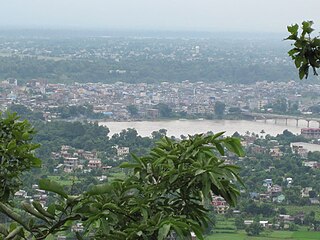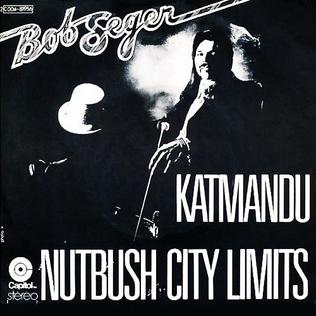Kathmandu is the capital of and largest city in Nepal.
Contents
- Places
- Arts, entertainment, and media
- Music
- Other uses in arts, entertainment, and media
- Other uses
- See also
Kathmandu or Katmandu may also refer to:
Kathmandu is the capital of and largest city in Nepal.
Kathmandu or Katmandu may also refer to:

Kathmandu, officially the Kathmandu Metropolitan City, is the seat of federal government and the most populous city in Nepal. As of the 2021 Nepal census, there were 845,767 inhabitants living in 105,649 households and approximately 4 million people in its surrounding agglomeration. It is located in the Kathmandu Valley, a large valley surrounded by hills in central Nepal, at an altitude of 4,344 feet above sea level.

Newar is a Sino-Tibetan language spoken by the Newar people, the indigenous inhabitants of Nepal Mandala, which consists of the Kathmandu Valley and surrounding regions in Nepal. The language is known officially in Nepal as Nepal Bhasa, a name that has been historically used for the language. The term "Newari" is also used to refer to the language, although the Indic -i suffix is considered inappropriate by some Newar speakers.

Newar, or Nepami, are primarily inhabitants in Kathmandu Valley of Nepal and the Indian territories of Sikkim state and Gorkhaland including its surrounding areas and the creators of its historic heritage and civilisation. The Newar are a distinct linguistic and cultural group, primarily Indo-Aryan and Tibeto-Burman ethnicities, who share a common language, Nepal Bhasa, and predominantly practice Newar Hinduism and Newar Buddhism. Newars have developed a division of labour and a sophisticated urban civilisation not seen elsewhere in the Himalayan foothills.

Pokhara is a metropolitan city located in central Nepal, which serves as the capital of Gandaki Province and is declared as the tourism capital of Nepal. It is the second most populous city of the nation after Kathmandu, with 599,504 inhabitants living in 120,594 households as of 2021. It is the country's largest metropolitan city in terms of area. The city also serves as the headquarters of Kaski District. Pokhara is located 200 kilometres west of the capital, Kathmandu. The city is on the shore of Phewa Lake, and sits at an average elevation of approximately 822 m above sea level. The Annapurna Range, with three out of the ten highest peaks in the world—Dhaulagiri, Annapurna I and Manaslu—is within 15–35 mi (24–56 km) aerial range from the valley.

The Kathmandu Valley, also known as the Nepal Valley or Nepa Valley, National Capital Area, is a bowl-shaped valley located in the Himalayan mountains of Nepal. It lies at the crossroads of ancient civilizations of the Indian subcontinent and the broader Asian continent, and has at least 130 important monuments, including several pilgrimage sites for Hindus and Buddhists. The valley holds seven World Heritage Sites within it.

Chitwan District is one of 77 districts of Nepal, and takes up the southwestern corner of Bagmati Province. Bharatpur, largest city of Nepal after Kathmandu, is its administrative centre. It covers 2,238.39 km2 (864.25 sq mi), and in 2011 had a population of 579,984 people. Bharatpur is the commercial and service centre of South Central Nepal and a major destination for higher education, health care and transportation in the region. Chitwan lies in the Terai region of Nepal. It is in the drainage basin of the Gandaki River and is roughly triangular, taking that river as its meandering northwestern border, and a modest watershed border, with India, as the basis of its southern limit. Local government: Bharatpur Metropolitan, Rapti Municipality, Ratnanagar Municipality, Kalika Municipality, Khairahani Municipality, Madi Municipality, Ikshyakamana Gaupalika

Kathmandu District is a district located in Kathmandu Valley, Bagmati Province of Nepal. It is one of the 77 districts of Nepal, covers an area of 413.69 km2 (159.73 sq mi), and is the most densely populated district of Nepal with 1,081,845 inhabitants in 2001, 1,744,240 in 2011 and 2,017,532 in 2021. The administrative headquarters of Kathmandu district is located in Kathmandu. The city has 21 post offices which handle mail from across the country and beyond, with Kathmandu DPO having 44,600 as its postal code for international mail delivery services like UPS or DHL Couriers etc.

Lamjung District, a part of Gandaki Province, is one of the 77 districts of Nepal. The district, with Besisahar as its district headquarters, covers an area of 1,692 square kilometres (653 sq mi) and as of 2011 had a population of 167,724. Lamjung lies in the mid-hills of Nepal spanning tropical to trans-Himalayan geo-ecological belts, including the geographical midpoint of the country. It has mixed habitation of casts and ethnicities. It is host to probably the highest density of the Gurung ethnic population in the country.

Sindhupalchok District is a part of Bagmati Province and one of the seventy-seven districts of Nepal, with an area of 2,542 km2 (981 sq mi). The district's headquarters is in Chautara. In 2006, 336,478 people resided in 79 village development committees; in 2011 there were 287,798.

1974 AD is a Nepali rock band, formed in Kathmandu, Nepal in the early 1990s. They experiment with various genres of music including Nepali folk, ragas, rock, funk, blues and jazz. 1974 AD are amongst the most successful recording artists in Nepal. Most of their albums are ranked amongst the top-ten best-selling albums according to Hits FM of Nepal. In 2000, their concert, 'Rock Yatra,' was watched by more than 60,000 people, the largest attendance for a concert in Nepal.
Gokarna may refer to:
Jagatpur is a small town of Bharatpur Metropolitan City and former village development committee in Chitwan District, Bagmati Province of Nepal. At the time of the 2011 Nepal census it had a population of 11,195 people living in 2,635 individual households.

"Katmandu" is a song written and recorded by American rock artist Bob Seger. It was initially released on his 1975 studio album Beautiful Loser, which became the first of ten consecutive platinum albums for Seger. The song was later featured on his live album Live Bullet. The single edit reached number 43 on the US Top 40, becoming Seger's most successful single since "Ramblin' Gamblin' Man". The song was featured in the soundtracks of the 1985 film Mask, the 16th episode of Freaks and Geeks, the tenth episode of the eighth season of Supernatural, and in the 2009 documentary Journey to Everest.

The ancient and refined traditional culture of Kathmandu, for that matter in the whole of Nepal, is an uninterrupted and exceptional meeting of the Hindu and Buddhist ethos practiced by its highly religious people. It has also embraced in its fold the cultural diversity provided by the other religions such as Kirat, Jainism, Islam and Christianity.
Sanjay Man Shrestha is a Nepali singer and musician. In 1992, Shrestha founded the pop music band Crossroads, which fused western-style singing and traditional Nepali instrumental music. Shrestha produced several popular songs, including the hit Maya Meri Maya.
The following is a timeline of the history of the city of Kathmandu, Nepal.

Bagmati Province is one of the seven provinces of Nepal established by the constitution of Nepal. Bagmati is Nepal's second-most populous province and fifth largest province by area. It is bordered by Tibet Autonomous Region of China to the north, Gandaki Province to the west, Koshi Province to the east, Madhesh Province and the Indian state of Bihar to the south. With Hetauda as its provincial headquarters, the province is also the home to the country's capital Kathmandu, is mostly hilly and mountainous, and hosts mountain peaks including Gaurishankar, Langtang, Jugal, and Ganesh.

Nautalle Durbar is a palace in Hanuman Dhoka, Kathmandu Durbar Square.